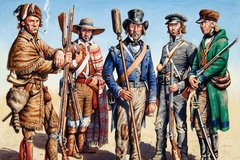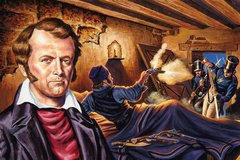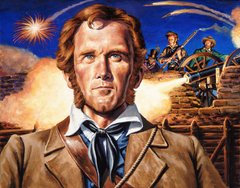[1] José Enrique de la Peña, With Santa Anna in Texas (College Station: Texas A & M University Press, 1997), 26–29; Vicente Filisola, Memoirs for the History of the War in Texas (2 vols.; Austin: Eakin Press, 1987), 2:157–159.
[2] Henry W. Barton, “The Problem of Command in the Army of the Republic of Texas,” Southwestern Historical Quarterly (January 1959), 300.
[3] John H. Jenkins, Papers of The Texas Revolution (10 vols.; Austin: Presidial Press, 1973), 4:176, 260–261.
[4] William Fairfax Gray, From Virginia to Texas, 1835: Diary of Col. Wm. F. Gray (Houston: Fletcher Young Publishing Co., 1965), 125. For Houston’s activities from January 28, 1836, to March 11, 1836, see Llerena B. Friend, Sam Houston: The Great Designer (Austin: University of Texas Press, 1985), 66–68.
[5] John H. Jenkins, Papers of The Texas Revolution (10 vols.; Austin: Presidial Press, 1973), 4:128, 160, 263–265, 324–325, 504–505. Béxar elected four delegates: Lorenzo de Zavala, José Francisco Ruiz, José Antonio Navarro, and Juan Seguin. On February 1, 1836, the Alamo garrison elected two delegates of their own: Jesse B. Badgett and Samuel Maverick. Maverick did not leave the Alamo until March 2, 1836.
[6] John H. Jenkins, “Notes And Documents: The Thermopylae Quotation,” Southwestern Historical Quarterly (October 1990), 299–304. Attributed to Edward Burleson, historians believe the quote was supplied to him for a speech as he had little formal education and would have most likely been unaware of this ancient battle.
[7] Alamo Education Department, Were there survivors at the Alamo?
[8] John H. Jenkins, Papers of The Texas Revolution (10 vols.; Austin: Presidial Press, 1973), 4:475, 502, 504; Alan Huffines, Blood of Noble Men: The Alamo Siege & Battle(Austin: Eakin Press, 1999), 103.
[9] John H. Jenkins, Papers of The Texas Revolution (10 vols.; Austin: Presidial Press, 1973), 5:22–23.
[10] John H. Jenkins, Papers of The Texas Revolution (10 vols.; Austin: Presidial Press, 1973), 5:69.
[11] John H. Jenkins, Papers of The Texas Revolution (10 vols.; Austin: Presidial Press, 1973), 4:11, 13–14; Eugene C. Barker, “The Texas Revolutionary Army,” The Quarterly of the Texas State Historical Association (April 1906), 227–261. For a discussion of volunteers within the American military, see Richard B. Winders, Mr. Polk’s Army: The American Military Experience in the Mexican War (College Station: Texas A & M Press, 1997), Chapter 5: The Volunteers.
[12] For a current and objective biography of Travis, see Willaim C. Davis, Three Roads to the Alamo (New York: HarperCollins, 1998).
[13] John H. Jenkins, Papers of The Texas Revolution (10 vols.; Austin: Presidial Press, 1973), 4:320, 327–328, 339,
[14] See Richard B. Winders, Mr. Polk’s Army: The American Military Experience in the Mexican War (College Station: Texas A & M Press, 1997), Chapters 4 & 5; John H. Jenkins, Papers of The Texas Revolution (10 vols.; Austin: Presidial Press, 1973), 3:306–308.
[15] John H. Jenkins, Papers of The Texas Revolution (10 vols.; Austin: Presidial Press, 1973), 4:46.
[16] John H. Jenkins, Papers of The Texas Revolution (10 vols.; Austin: Presidial Press, 1973), 4:127, 424–425,.
[17] John H. Jenkins, Papers of The Texas Revolution (10 vols.; Austin: Presidial Press, 1973), 4:236–238.



